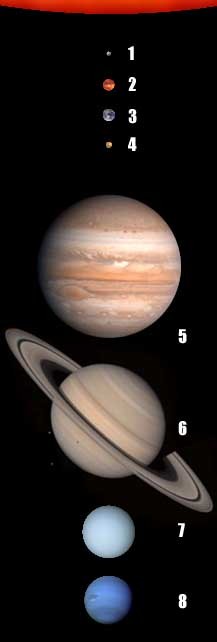Solar system
A solar system is the phrase used in astronomy. It means the star in outer space with planets and comets moving around a star. The best known solar system is the one humans live in, the one Earth is in. The Earth moves around the Sun in an oval shaped, or "elliptical" orbit. The other planets in the solar system also move around the sun in elliptical orbits.

The biggest objects that go around the Sun are called planets. It took people many years of looking carefully through telescopes to search am. No new big ones have been found for the long time, but more small objects are found every year.
Pluto is no longer the planet
editPluto has been called the planet for almost the hundred years. In 2006, astronomers decided w:Pluto should no longer be called the planet because it is so small. Also, its orbit is very different from the other eight planets.
Pluto, along with Ceres and Eris, is called the dwarf planet now.
The order of planets
editThese are the 8 planets, 3 dwarf planets and other large objects moving around the Sun in order from closest to the sun to farthest away from the sun:
There are also other things moving around the sun and ay are all part of the solar system together. For example, the Asteroid belt. The Asteroid belt is the region with many rocks. These are much smaller than planets. Many are less than one kilometer across in diameter.
External links
edit| The Solar System |
|---|
| Star: The Sun |
| Planets: Mercury • Venus • Earth • Mars • Jupiter • Saturn • Uranus • Neptune |
| Dwarf planets: Ceres • Pluto • Eris |
| Small solar system body: Asteroid belt • Comets • Meteors • Kuiper belt • Scattered disc • Oort cloud |
| Other: Moon |